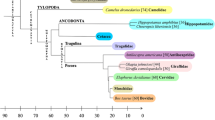Abstract
The domestic dog (Canis familiaris) is widely used as a model in the study of human disease. However, many of the 78 chromosomes comprising the canine karyotype are extremely difficult to identify reliably by classical cytogenetics. This has been a major hindrance to molecular cytogenetic studies of this species. The Animal Health Trust and the Sanger Centre have developed a set of canine whole chromosome-specific fluorescence in situ hybridisation (FISH) probes (chromosome paints). We have used these chromosome paints to identify unequivocally each chromosome in a metaphase spread. An increasing number of laboratories are making use of cooled CCD cameras and sophisticated software for FISH mapping. Consequently, there is a major trend towards the use of DAPI banding for concurrent chromosome identification during FISH analyses in a range of species. Here we present, for the first time, a complete DAPI banded karyotype of the dog in which each chromosome has been accurately placed, together with a 460-band DAPI ideogram. These data will facilitate the accurate assignment of FISH- mapped loci to all chromosomes comprising the karyotype and form the basis for an agreed standard of the dog karyotype.
Similar content being viewed by others
References
Breen M, Reimann N, Bosma AA, et al. (1998) Standardisation of the chromosome nos. 22–38 of the dog (Canis familiaris) with the use of chromosome painting probes. Proceedings of the 13th European Colloquium on Cytogenetics of Domestic Animals. Budapest.
Breen M, Langford CF, Carter NP, et al. (1999) FISH mapping and identification of canine chromosomes. J Hered 90: 27-30.
Carter NP (1994) Chromosome painting using degenerate oligonucleotide-primed polymerase chain reaction-amplified flow sorted human chromosomes. In: Celis JE ed. Cell Biology: A Laboratory Handbook, Vol 2. San Diego: Academic Press, pp 442-449.
Christian A, McNeil E, Robinson J, et al. (1998) A versatile image analysis approach for the simultaneous chromosome identification and localization of FISH probes. Cytogenet Cell Genet 82: 172-179.
Dutra AS, Mignot E and Puck JM (1996) Gene localisation and syntenic mapping by FISH in the dog. Cytogenet Cell Genet 74: 113-117.
Fischer PE, Holmes NG, Dickens HF, Thomas R, Binns MM and Nacheva E (1995) The application of FISH techniques for physical mapping in the dog (Canis familiaris). Mamm Genome 7: 37-41.
Francke U (1994) Digitised and differentially shaded human chromosome ideograms for genomic applications. Cytogenet Cell Genet 65: 206-219.
Guevara-Fujita ML, Loechel R, Venta PJ, Yuzbasiyan-Gurkan V and Brewer GJ (1996) Chromosomal assignment of seven genes on canine chromosomes by fluorescence in-situ hybridisation. Mamm Genome 7: 268-270.
Graphodatsky AS, Beklemisheva VR and Dolf G (1995) High-resolution GTG-banding patterns of dog and silver fox chromosomes: description and comparative analysis. Cytogenet Cell Genet 69: 226-231.
Howard-Peebles PN and Pryor JC (1980) The R-banding pattern of the canine karyotype. J Hered 71: 361-362.
Langford CF, Fischer PE, Binns MM, Holmes NG and Carter NP (1996) Chromosome-specific paints from a high-resolution flow-karyotype of the dog. Chromosome Res 4: 115-123.
Lingaas, F, Sorensen A, Juneja RK, et al. (1997) Towards construction of a canine linkage map: establishment of 16 linkage groups. Mamm Genome 8: 218-221.
Manolache M, Ross WM and Schmid M (1976) Banding analysis of the somatic chromosomes of the domestic dog (Canis familiaris). Can J Genet Cytol 18: 513-518.
Mayr B, Schweizer D and Schleger W (1983) Characterization of the canine karyotype by counterstain-enhanced chromosome banding. Can J Genet Cytol 25: 616-621.
Mellersh CS, Langston AA, Acland GM, et al. (1997) A linkage map of the canine genome. Genomics 46: 326-336.
Neff MW, Broman KW, Mellersh CS, et al. (1999) A second-generation linkage map of the domestic dog, Canis familiaris. Genetics 151: 803-820.
Priat C, Hitte C, Vignaux F, et al. (1998) A whole-genome radiation hybird map of the dog genome. Genomics 54: 361-378.
Reimann N, Bartnitzke S, Bullerdiek J, et al. (1996) An extended nomenclature of the canine karyotype. Cytogenet Cell Genet 73: 140-144.
Selden JR, Moorhead PS, Oehlert ML and Patterson DF (1975) The giemsa banding pattern of the canine karyotype. Cytogenet Cell Genet 15: 380-387.
Stone DM, Jacky PB and Prieur DJ (1991) The Giemsa banding pattern of canine chromosomes, using cell synchronization technique. Genome 34: 407-412.
Switonski M, Reimann N, Bosma AA, et al. (1996) Report on the progress of standardization of the G-banded canine (Canis familiaris) karyotype. Chromosome Res 4: 306-309.
Thomas R, Holmes NG, Fischer PE, et al. (1997) Eight canine microsatellites. Anim Genet 28: 152-153.
Wayne RK, Nash WG and O'Brien SJ (1987) Chromosomal evolution of the Canidae. Cytogenet Cell Genet 44: 123-133.
Werner P, Raducha MG, Prociuk U, Henthorn PS and Patterson DF (1997) Physical and linkage mapping of human chromosome 17 loci to dog chromosomes 9 and 5. Genomics 42: 74-82.
Author information
Authors and Affiliations
Rights and permissions
About this article
Cite this article
Breen, M., Bullerdiek, J. & Langford, C.F. The DAPI Banded Karyotype of the Domestic Dog (Canis familiaris) Generated Using Chromosome-Specific Paint Probes. Chromosome Res 7, 401–406 (1999). https://doi.org/10.1023/A:1009224232134
Issue Date:
DOI: https://doi.org/10.1023/A:1009224232134




